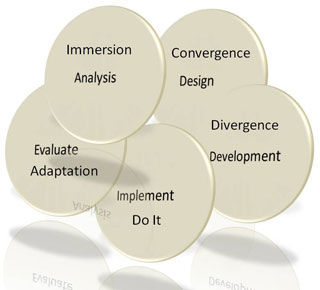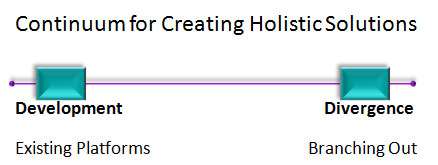This is the fourth post in a series on extending ADDIE in order to solve wicked or complex problems:
- Post 1: Innovating With ADDIE
- Post 2: Analysis and Immersion
- Post 3: Design and Convergence

Development in ADDIE is typically thought of as creating the learning content, products, and services, in addition to selecting the media that will carry or deliver them to the learners. Frog Design defines Divergence as branching out beyond what is normally does in its ecosystem in order to take in a wider footprint that provides a holistic solution:

The Development and Divergence Continuum works differently from both the other two ones:
- In the Analysis and Immersion Continuum the complexity of the environment determines at what point you are on the scale.
- In the Design and Convergence Continuum the goal is to aim for the center of the scale.
While the goal in the Development and Divergence Continuum is to aim for both ends — combine “what works” with “what will make it better."
For example, blended learning is normally considered a combination of elearning and classroom learning. eLearning allows the learners to learn at their own pace, while the classroom portion provides the needed social engagement. The Army has found this to be a superior form of learning and is now moving to a dL (distributed Learning) environment. Note that the “d” is not capitalized as only the “Learning” is emphasized — classroom learning is used when it makes sense.
Another example is the greater consideration of informal and social media when creating formal learning platforms.
Thus, rather than just working from just one point in the scale, Development can often be improved by working from two or more points in the scale.
Up next — Evaluate and Adaptation.
No comments:
Post a Comment